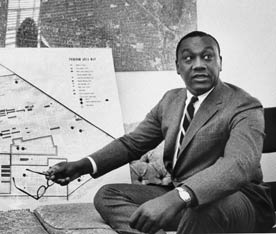Economic stimulation is the primary community-building focus in the vast majority of the United States we still refer to as rural. Within the NeighborWorks Rural Initiative, affordable-housing programs are valued as much for their affect on the economy as for their impact on local inventories of affordable units.
Rural NWOs that begin as local and regional housing-service providers are often pulled into complementary lines of business such as community facilities and economic development because they may be the only organization in the region. It’s not just the houses that are far apart in rural areas; the build-out of nonprofit infrastructure is commensurately thinner in rural America, particularly in the areas that are perennially underserved, such as the Delta, the colonias, Appalachia, and Indian Country.
In Carizzo Springs, a small South Texas community tucked in among hundreds of square miles of mesquite and sage, the local leaders of Neighborhood Housing Services of Dimmit County, one of the first rural NWOs in the nation, realized that housing services alone could not lift the economy of this middle Rio Grande region. “We got into economic development over 10 years ago because if you have a home, any home, without a job, it’s not affordable. We needed jobs,” says Manuel Estrada, who has served as executive director for more than 25 years.
Neighborhood Housing Services of Dimmit County continues to offer housing services, but it also maintains a commercial loan portfolio of more than $1.6 million. Between 1995 and 2005 the organization generated $17.6 million in capital investments through economic development within a nine-county service area. In addition, it partners with a far larger NeighborWorks organization, Business and Community Leaders (BCL) of Texas, which serves the cities of Austin and Dallas, in a regional collaborative called TREE, or Texans for Rural Entrepreneurship and Education. TREE is designed to “foster rural entrepreneurship throughout rural Texas through education, policy, access to capital, and service delivery.”
Dimmit’s partnership with BCL allows the Carizzo Springs program to remain small but to extend both its programmatic reach and access to capital. By collaborating within TREE, NHS of Dimmit County can access a broad range of added-value services without increasing its overhead.
Trend Toward Statewide Networks and Collaborations
Whether CDCs grow their own shops to statewide scale or choose to participate in some form of network structure, there is a marked trend toward statewide organizational structures. For state and federal funders, there’s an enormous difference between having to contract with a patchwork quilt of nonprofits who in aggregate only serve a portion of a state, and having a single organizational point of contact that can deliver services across an entire state. For individual CDCs there are tremendous advantages as well. Statewide contracts and partnerships typically open up larger resources for individual CDCs than they could ever access on their own. In addition, statewide networks offer ongoing opportunities for peer-to-peer learning and exchange of information. Perhaps most important, these new networks can become strong platforms with political clout and the ability to shape community development policy.
NeighborWorks Montana uses a highly innovative and productive partnership model that brings together major housing players from public and private sectors to promote sustainable homeownership. Partners range from the Rural Development arm of the United States Department of Agriculture to local public-housing authorities, from Fannie Mae to local community banks, from the Montana Housing Finance Agency to local Realtors. The organization provides outreach to some of the most remote areas in rural America, including the seven Native American reservations within the state.
During successive national campaigns to boost homeownership rates starting in the 1990s, NeighborWorks Montana has regularly been among the top five producers of first-time homebuyers in any market. For those who have puzzled over Montana’s ability to deliver exceptionally high production with exceptionally low overhead costs, what surfaces again and again is the statewide partnership model, a highly efficient and effective use of individual partners’ skills and resources to reach rugged and remote areas of a state that, by anyone’s definition, is the epitome of “rural.”
In Vermont, five NWOs formed a highly interactive statewide network to offer a full range of standardized homeownership services. The organizations meet regularly to set common goals, explore new partnership opportunities, and evaluate their progress. And as in Montana, the NeighborWorks Alliance of Vermont has parlayed its statewide coverage into a successful and ongoing resource-development strategy that has yielded progressive agreements with the Vermont Housing Finance Agency and USDA Rural Development, along with operating funds from private fundraising campaigns in support of the five customer service hubs known collectively as the NeighborWorks HomeOwnership Center of Vermont.






Comments